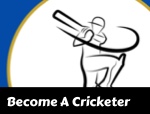|
 Before you can smash that half volley through the covers for a searing boundary, you need to pick up the half volley. That's shot selection in action and - as batsmen and coaches - we should never take it for granted. Before you can smash that half volley through the covers for a searing boundary, you need to pick up the half volley. That's shot selection in action and - as batsmen and coaches - we should never take it for granted.
But how do you train for shot selection?
Learning the technique of a shot is much easier. You are moving. You can get feedback. You can drill repeatedly until you get it right. But it's hard to come up with "drills" for a process that only goes on in your head: While you are identifying the line and length of the ball, and then choosing a shot, you are not doing anything with your body.
Fortunately, it's simple to integrate shot selection specific drills into your normal training. Here's some things you can do.
Decide your shots
Start with basic principles. Ask yourself, "in an ideal world, how would I deal with different types of balls?"
This is mostly simple; you drive the full ones, you cut and pull the short ones. But there are grey areas. Do you sweep spinners or use your feet? How do you deal with a length ball at the death? What shots do you cut out when your team loses five wickets for 20 runs?
Stick to shots you know you can play at first. You may also decide to learn a new shot or two, but begin with what you have. And be honest. If you can't play the flick off your legs then don't imagine you will start now because you have planned it. If you only have two reliable shots then stick to them. They will get you a long way.
You can make these kind of decisions away from nets and games where it's easy to think things through with an uncluttered mind. Use this as a starting template to avoid temptation through scoreboard pressure.
(You can also use nets as "thinking time" but they need to be set up in a very particular way to be effective, so unless you are going to do this, keep the thinking and playing separate.)
How to adapt nets to shot selection
We know from research into elite batsmen that facing bowlers improves your ability to quickly pick up line and length. So, nets are ideal.
Where most of us go wrong is not tracking what happens in nets. We rely on memory and hope. We say things like "I felt good today" or "nothing went well today" when in reality it's usually a mixture of results that we can only see properly by reviewing the whole session.
So, when you feel you need a shot selection tune up, you can have your normal net with normal bowlers (or a coach with bowling with a sidearm). However, you also need a way to track what happened.
Tracking is best done with video, but you can also do it with hand notation. Keep a note of each ball and whether you chose the right shot (based on your own standards). Did you nick that half volley while trying to drive? That's a technique issue not a shot selection issue. You get a gold star for picking the ball even though you would have been out in the game.
At the end of the session you will have a certain number of balls you got right, and a certain number you didn't. Aim to increase the former and reduce the latter over a period of a few sessions.
Additionally, it helps if fewer bowlers bowl at you in nets because it give you time to pick up the cues you need from each individual action. So, if possible, get bowlers to bowl at you in overs one or two at a time.
When the session is over, take a moment to think through how it went initially and what you might like to do next time. Then between sessions, review your performance in more detail (look at the video, review the stats) and be sure you are planning ahead for the next session based on the results of the last. Imagine you are an airliner and this review process is your autopilot keeping you exactly on course by constant minor adjustments.
Warning: Avoid the machine
One tool for batting to avoid while you are working on shot selection is the bowling machine.
They are wonderful tools for technical work, but remember shot selection is all in the head. That means you need to be able to see someone delivering the ball, and you need to be uncertain exactly where the ball is going. The bowling machine can't provide that.
Clearly, your best option is to face bowlers. If your main aim is shot selection, a net works best because you don't have the pressure of the game situation. However, eventually you need to apply your skill under pressure too, so middle practice is also a good place to improve your shot selection.
Another good option is a coach. If the coach can bowl to your standard then have her bowl! Even if they are not quite as good as you want, getting them to bowl from 18 yards is an option. If she can't bowl to the standard you need, then turn to the sidearm. This gives even the most terrible bowler much more pace. The best option is to have the coach bowl with it. It does take practice but it's worth it.
Review like your career depends on it (it does)
Drills are great, but they are far less effective unless you build in a review.
So, consider it a golden rule that your session is not complete until you have done a review. Don't panic, this doesn't have to take a long time.
Spend 2-5 minutes after your net to think about the session. Discuss it with a coach or team mate if you want or quietly reflect to yourself as you take off your pads. Make a couple of notes about how it went and what you want to do next time. These can be mental notes, a quick scrawl on a pad, an entry in Drafts , notes in PitchVision, or 12 pages of feels in your diary. Whatever works for you.
Between sessions, go back to the results of the session and look in more detail. You should have tracked something over the session so you might be satisfied with "I improved this week, great!" or you can sift through the data with a fine toothcomb. That will all depend on your personality, but the key point is to have a second check over things before your next session and decide what you will do.
Then at the session, make sure you have let someone know your goal for the session before you walk in to bat. Again, there are options for this. You can tell the coach, tell the bowlers or write it on a whiteboard. This is a key step because it makes you accountable. You are more likey to stick to the plan if someone is watching.
Repeat, adjust and improve.
Discuss this article with other subscribers
|

.jpg)



.jpg)

